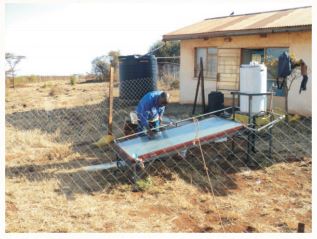Using a solar milk pasteurizer, smallholder farmers seeking to minimize milk losses along the marketing chain especially in the arid and semi-arid lands has been developed by the Kenya Agricultural and Livestock Research Organization. The new technology will help milk farmers and business vendors prolong the shelf life of milk and hence improve market- ability and generate more income.
Milk marketing is an important income earning opportunity for people in the arid and semi-arid lands (ASALs) of Kenya. For a long time, farmers have been using limited firewood to boil the milk hence placing intense pressure on the forests and destroying the environment.
READ ALSO: Simple Solar technology for irrigation saves water & fertilizer costs
The solar milk pasteurizer consists of a flat-plate water heating solar collector and a stainless steel cylindrical milk container. Water in the solar collector is directly heated by the sun and the hot water produced used for pasteurizing milk.
According to Marsabit KALRO officer F.Wayua, the abundant solar energy in ASALs can be used to pasteurize milk. A simple solar milk pasteurizer can be made locally with the aid of jua kali artisans. The materials required for fabrication include a flat plate solar collector, a stainless steel cylindrical tank, connecting pipes& valves and insulating materials (fiber glass, cotton, wool and saw dust). The materials can be obtained from native hardware shops close to the farmers’ residence.
READ ALSO: Solar and wind hybrid drier saves food
After assembling and the device is ready for use, it is advisable to tilt the solar collector at 10-15° from the horizontal, facing the equator. Ensure you have good quality milk to be pasteurized and a piece of clean sterile (boiled) cotton cloth.
READ ALSO: Solar powered mini silos tames grain loss
Procedure for Milk Pasteurization
- Pasteurization should be done between 10 am and 4 pm when there is adequate solar radiation
- Fill the system with water in the morning
- Sieve milk using the cotton cloth
- Pour the sieved milk in the milk container
- Water in the solar collector is directly heated by the sun
- The hot water produced is used for pasteurizing milk in the milk container
- Circulation of hot water from the collector to the jacketed milk container continues as long as the sun is shining
- Let the milk heat to 63°C and hold for 30 minutes or 85°C (when it starts to foam) and hold for 5 seconds.
The device is recommended for producers and milk traders in arid pastoral areas as they have limited access to grid electricity but have plenty of solar radiation. Milk Pasteurization makes milk safe for human consumption.
For more information contact: Centre Director, KARI Marsabit P.O. Box 147 – 60500 Tel. 069 – 2040 Wireless: 020 801 7018 Email: This email address is being protected from spambots. You need JavaScript enabled to view it.

















Comments powered by CComment